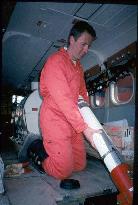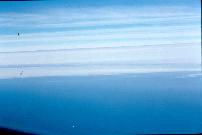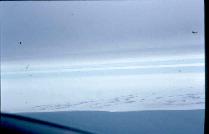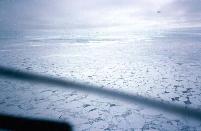



Subject: Official: Bombs away!
Yesterday (18/2) Andy Allsop flew me in VP-FAZ to drop the CALIBS. From the DTU passve microwave imagery I had identified two reasonably stable looking areas of high ice concentration within reach of Fossil Bluff. The first was around 71S 90W, towards the tip of a tongue of ice extending W from Thurston Island. The second was off the Ronne Entrance at around 72S 80W.
After fuelling at Fossil Bluff at 1200 we headed west at 12000 feet with 8/8 cloud tops below us. However this cleared further west and we approached the first drop area at 1415 with the ice edge clearly visible ahead. Unfortunately, on crossing the edge, the pack was seen to consist of a compact mass of small (10-20m) floes with a lot of brash in between - we estimated 50% solid ice and 50% brash/open water. We continued for 30 mins (60 nm) but there was little change in conditions. As we were approaching our "point of no return" we decided to make the first drop. CALIB 21388 was deployed at 1810 UTC at 70 53S, 87 23W from 1000'. We then turned for our return flight and deployed CALIB 21384 at 70 57S, 87 03W at 1825 UTC. We attempted to confirm that these drifters had landed on floes, but were unsuccessful due to poor contrast (8/8 cloud overhead).
We then proceeded to the second drop area and deployed 21376 at 1635 on somewhat larger floes from 500' at 71 47S, 80 14W. This time we were able to spot the CALIB on a floe - contrast was much better as there was a break in the cloud above us. We then returned to Fossil Bluff, landing with ample fuel left, and spent the night there, returning to R this morning in perfect wx.
Obviously we will have to wait to see how successful we have been. The logistics all worked very well - the DTU ice imagery provided good guidance (essential, given the cloud cover), the aircraft had the necessary range and the launch tube worked effectively. However, I was very surprised at the state of the ice - these extensive areas of very small floes are not something that I would have expected from my Weddell Sea experience. The area is clearly subject to strong wind/wave forcing and I am not optimistic about the floes surviving through to the freezing season - that is assuming we managed to hit floes with 88 and 84. I would like to think that I am being overly pessimistic but I think that it could be another month before freezing starts in earnest.